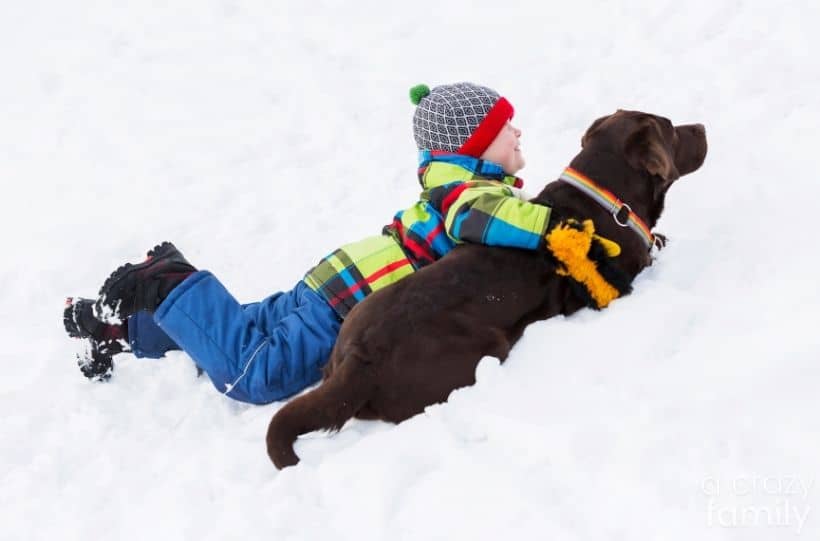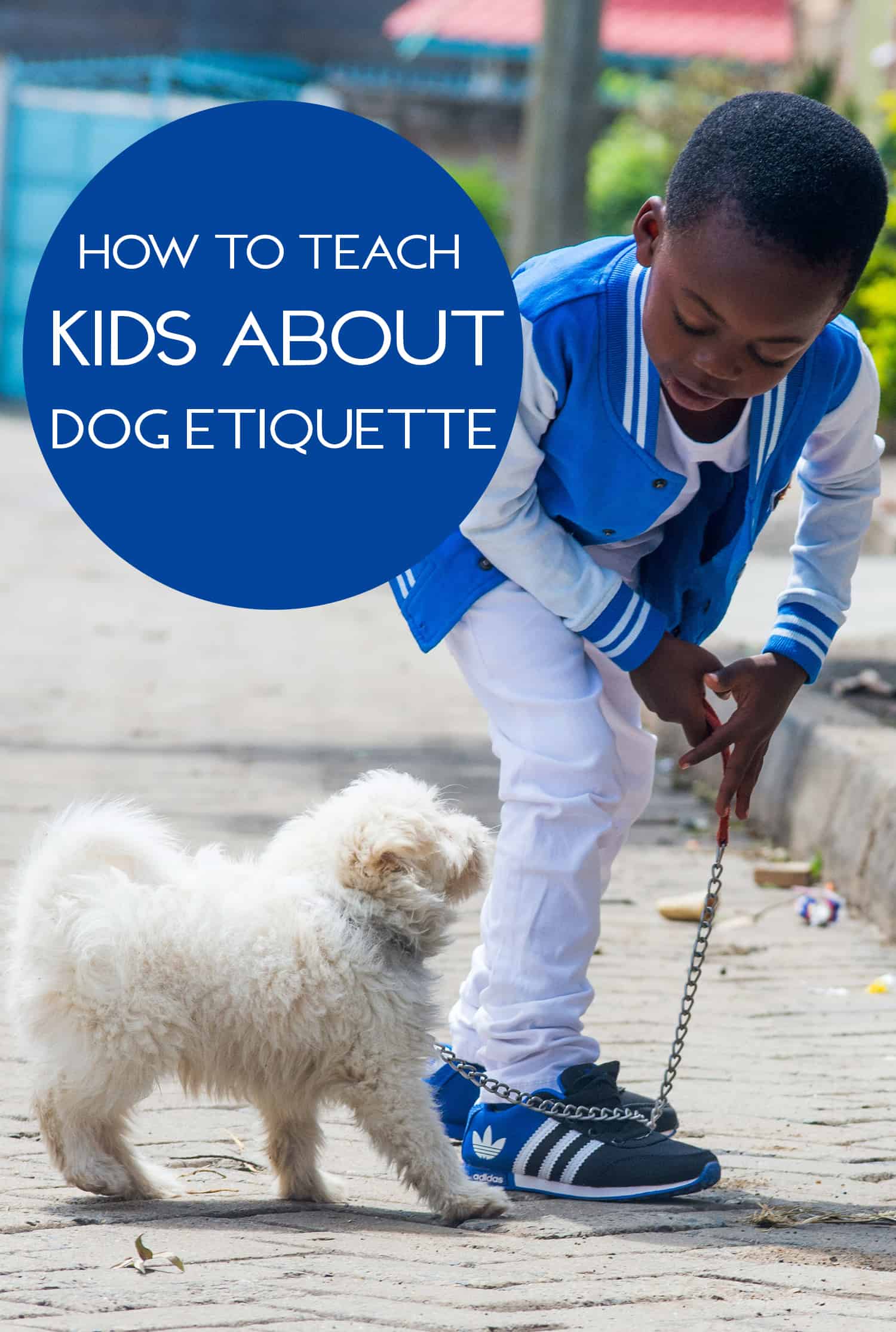Most people love dogs. After all, there’s a reason they are known as “man’s best friend.” Dogs are loyal, intelligent, and make excellent companions.
Dogs think differently than humans, however, and that can lead to some behavior issues and accidents – especially when it comes to dogs and children.
Both children and dogs can act in unpredictable ways.
Sometimes dogs perceive the way kids act as a threat, even when they’re well-meaning. This can lead to biting, barking, and other negative reactions.
By helping kids understand more about how dogs think and behave, we can help ensure harmonious relationships.
Here we cover what kids need to know about behaving around a dog, training a dog, and having good etiquette.
Thinking of getting a dog to join your family? Here are 10 Dog Breeds for Families with Small Children.
Understanding Dogs
Humans and dogs have been living alongside each other for tens of thousands of years, but the two species still think differently. While we can’t know exactly what’s going through a dog’s mind, our collective experience with them and canine research give us valuable insight into their behavior.
First and foremost, dogs are predators. Dogs hunt, chase, and kill other animals for food in the wild. This is why dogs can be wary of people who make sudden or jerky movements (for example).
Dogs are extremely sensitive to movement and sound, and they can read human body language very well. For example, a dog might start wagging its tail when it sees its owner because it knows the person is happy. They are also quite attuned to human language, being able to understand hundreds of words.
In general, dogs like routine and predictability. They are happiest when they know what is expected of them.
This is why training is so important – it establishes boundaries for dogs and gives them a sense of control and security. Training should always begin as soon as possible. According to professional dog trainer Emilee Mahar of SmartK9, “Your dog is learning something every single second, whether you like it or not.”

The Basics of Dog Etiquette
There are a few basic rules of dog etiquette that all kids should learn, whether you have your own dog or not. These rules will help keep your child safe when interacting with dogs.
- Always ask a dog’s owner if it is okay to pet their dog before petting. Not all dogs are comfortable with strangers.
- Don’t bother a dog when they are sleeping, eating, or chewing on a toy. Dogs can be very protective of their resources and may lash out.
- Don’t stare at a dog for long periods of time because they might perceive it as a threat. It can make them uncomfortable and even aggressive.
- Never pull on a dog’s tail or ears – it hurts them.
- Don’t encroach on a dog’s space. Dogs are den creatures, and they need their personal space respected. Don’t bother a dog when they are in their crate.
- If a dog is growling or barking, back away and give them some space. It’s important to remember that these behaviors usually mean the dog is feeling uncomfortable or threatened.
- Whenever possible, call a dog to you instead of approaching them. This will help the dog feel more comfortable.
- Don’t pat a dog on the head. It’s natural for us to do so, but can be uncomfortable for the dog. Many dogs appreciate being pet on the chin or back.
- Don’t yell or scream around dogs. Excessive noise can scare or frighten dogs, especially when it’s unpredictable.
Opportunities to Learn About Dog Behavior
If you want your child to have the opportunity to interact with a dog safely and with good manners, there are many ways to do so. Here are a few ideas:
- Ask friends and family members that have dogs if you can take your child to visit them. Some people might even be willing to let kids sit and pet the dog as long as an adult is nearby.
- If you want your child to be able to experience a wide variety of dogs, consider volunteering at an animal shelter.
- Offer to dog sit for a friend when they travel or work.
- Enroll your child in a dog training class.
- Attend a local dog park. While it’s best not to approach strange dogs, it can be a good opportunity to observe canine behavior. This can be a great way for kids to see how different dogs interact with one another.
Interacting with dogs of many different breeds, ages, and temperaments is the best way to get a well-rounded look at dog behavior.
Caring for Your New Dog
It’s inevitable: every kid that loves dogs wants one as a pet at some point in their life or another. It’s a huge responsibility, though, and there is a lot that needs to happen to make sure your dog can thrive.
Before bringing home a furry new family member, there are a few things your child should know.
- Dogs need exercise to stay both mentally and physically fit.
- Dogs need fresh water and food daily.
- Dogs need regular visits to the veterinarian.
- Dogs need training. It’s important to establish rules and boundaries for a dog from the start. This will help prevent bad behaviors down the road. Training isn’t “mean” – boundaries help your dog understand the world!
- Dogs need a place to call their own. This can be a crate, designated spot on the couch, or bed.
- Dogs are social animals and should have plenty of human interaction.
- Dogs need grooming. While different breeds have different requirements, all dogs will need some care. Nail trimming, brushing, oral care, and cleaning their ears are the bare minimum.
Having a dog is a huge responsibility, but it’s also one of the most rewarding experiences a child can have. With proper preparation, your family can be ready to take on the challenge!
Dog etiquette is a vital set of knowledge for everyone, dog owner or not. Knowing how to interact with dogs safely and respectfully will help to ensure that both the dog and the person are comfortable and happy.
Teaching kids about dog etiquette is a great way to help them learn empathy, responsibility, and how to handle difficult situations. When it comes down to it, good dog etiquette boils down to one simple rule: be kind.
